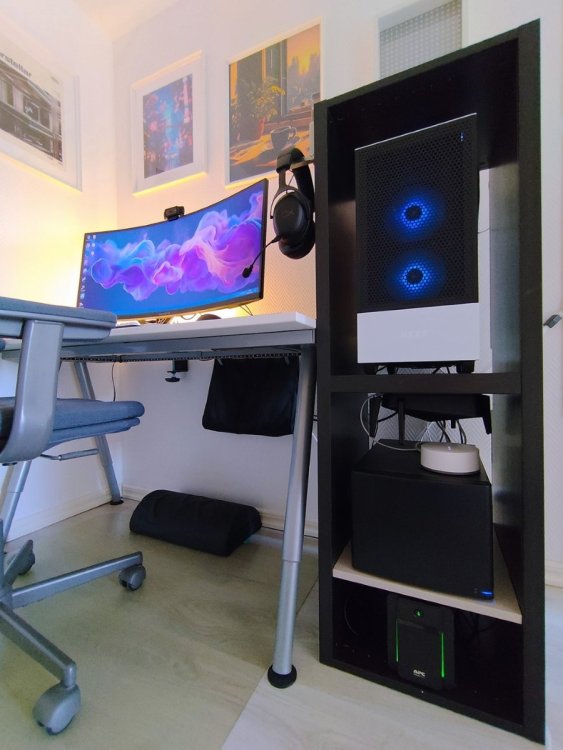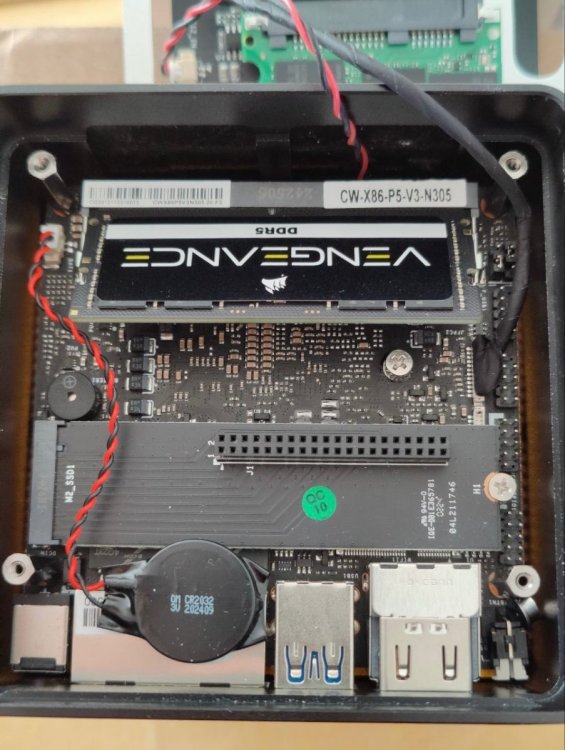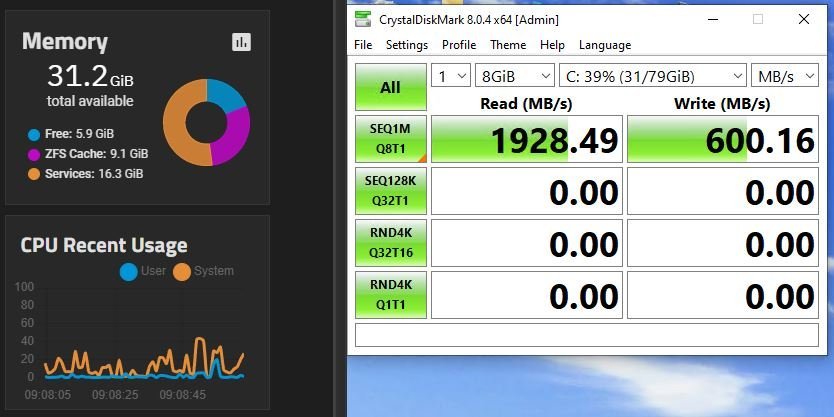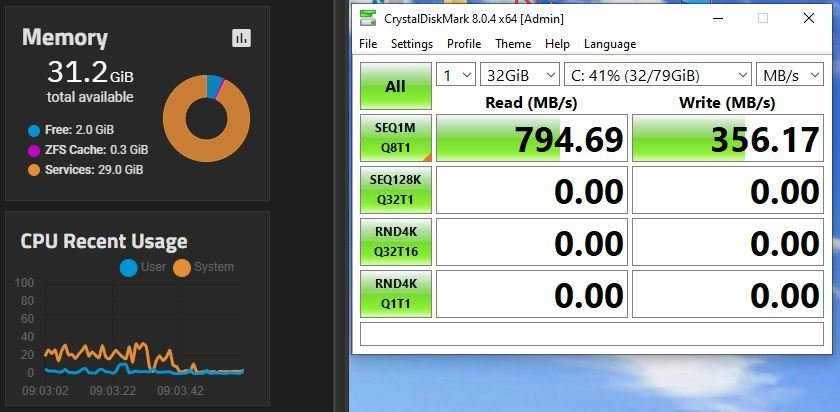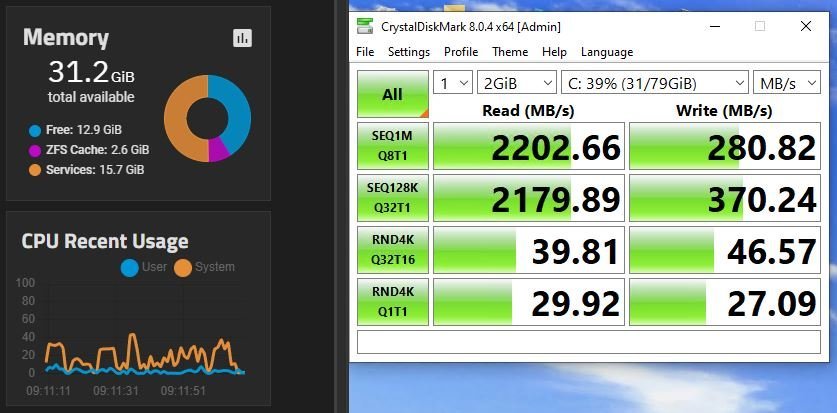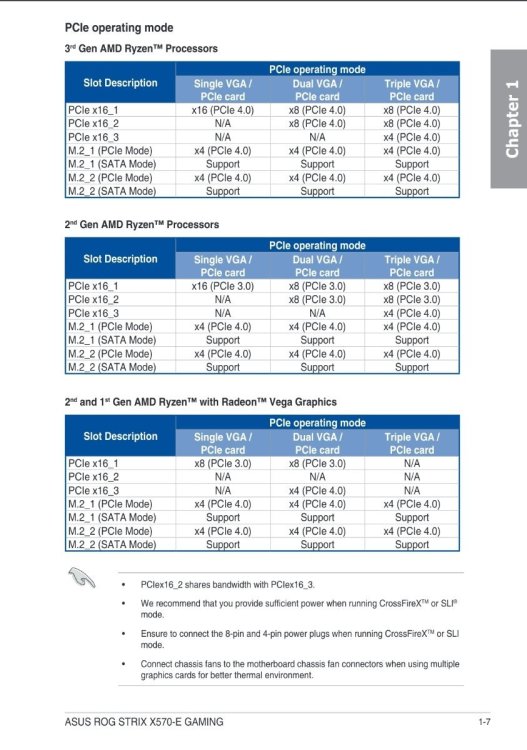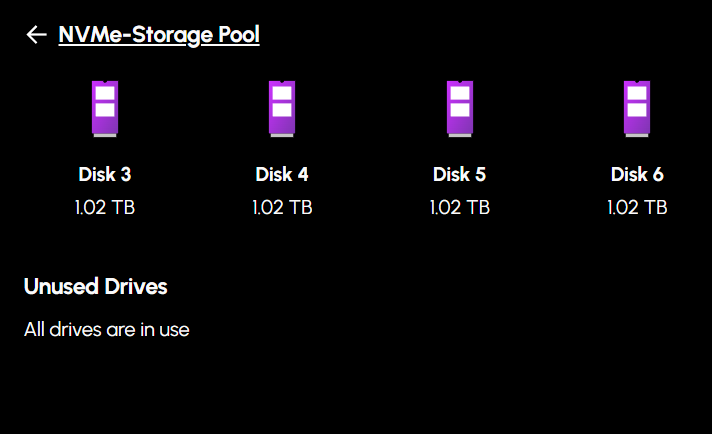All Activity
- Past hour
-
bullox185 joined the community
- Today
-
The other day I securely erased my Synology NAS. Marking the start of my future with HexOS and TrueNAS after a few months of testing. I went from three mini PC:s and one synology NAS to this: The pic includes my main gaming rig - the NAS is the black box. The box that now runs all my services including a VM with Windows for certain windows specific tasks. The NAS specs: Fractal Node 304 case Gigabyte A520I AC ITX motherboard Ryzen 5700G (8C/16 threads) 32GB 3200mhz (memtested 24h) 3x 4TB HDDs (can expand to 6 drives as needed) GTX 1060 for steam streaming - isolated for the windows VM PSU 350w (The NAS draws 60w idle) APC UPS What’s running: Transmission Immich VPN Minecraft server Windows VM (“Steamcache”, streaming and more) NUT-server (as the UPS is shared with the gaming rig) Cloud backups Samba of course More to come (the hardware is barely working) Problems setting it up: There were some but so few that I can't even remember them. Mostly with HexOS on testing-hardware not the final parts. Looking forward to everything coming in the future. But honestly… I’m fine 😎
-
RandomGeekyGuy joined the community
-
AgentMyth joined the community
-
t-willy joined the community
-
Plex - Remote Access - Not available outside your network
Todd Miller replied to Richj73's topic in Applications
Can you add a picture please? I am wrestling with Tailscale/reverse proxy/Cloudflare and getting remote access. For Plex I get remote access sometimes and not other times. Since I seriously doubt this is a HexOS issue I am trying to talk to Plex themselves. I would not be surprised if I jus missed something like this or have it in the wrong place. Thanks. -
Teito joined the community
-
DannyZia joined the community
-
Hi, I missed the $99 offer. Didnt know about it. Think the price is higher at $199 and yet even higher @ $249. Anyways, I have a unique situation. I cannot pay more than $150 per transaction. So, either keep the price $150 for me i/o $199. Or let me pay in two installments. Regards, Zia.
-
semicolon4684 joined the community
-
wulimaster joined the community
-
KRR127 joined the community
-
So, installed and ready, would it work? TrueNAS dashboard has the answer. Success 😀 Next step would be playing with storage files. After I got the hang of smb shares…
-
Just one thing I forgot to mention earlier. My SSD chip should be connected to SATA 2 or SATA 3 on the motherboard, according to ipc.net support (Jessica Fang). The one I used, the more easily available is SATA 3 to the middle right in this photo, with the black connector and cable visible. You can also see half of another SATA port just below in the photo, with the other half hidden under the board above it.
-
By now I feel comfortable opening up this computer case, and here is the pre-installed RAM, top of the picture. The two shiny metal ”handles” left and right of the stick you push outwards to release the stick. New RAM installed, ready to be pushed down, to sit properly. Second picture.
-
Literally had that recently when getting my remote server, bought a second hand system with a board that had built in IPMI, but then it doesn't work, as to use the software even in a browser, it needs Java that's so old it's blocked across ALL OS's... 🫠 i even created a windows 7 VM to attempt to use it to no avail haha... Jet KVM > Plug & Play! 🙏🏻
-
About two weeks ago I mentioned I got a 48GB RAM stick, for a spare or for upgrade at some point. Could I resist installing it now? No. 48GB is the max RAM possible here, and I believe it doesn’t hurt with a little more of it 😉
-
Just to add a little more info about NVME performance in this configuration, I know the 'bottleneck' is going to be the 2.5GbE NIC, but as I also mentioned I also run a Windows VM on the NAS. I just built another VM for some testing and thought it would be appropriate to run CrystalDiskMark on it, results below; In this run (above) I think the ZFS cache absorbed the 'test file' and massively accelerated the read performance. In this one I increased the memory allocated tot he VM with the intention of making it unavailable for ZFS caching. I'm aware that I could have disabled it on the pool but I have other things running on there and I thought this way would be more representative of a system being starved of memory. This one was (I think) more representative of the windows experience I'm seeing. Windows is very usable over RDP and I noticed no performance issues in the tasks I was using it for.
-
Plex - Remote Access - Not available outside your network
Richj73 replied to Richj73's topic in Applications
I seem to have resolved this my simply adding the local IP to the custom port field 192.168.68.72:32400 Hope this helps someone in the future! -
Less technical user dives in to backups and installing apps!
Todd Miller replied to gingerling's topic in Show & Tell
Agreed. Maybe we need to start saying our level of expertise is more inline with novice instead of saying less technical. - Yesterday
-
Keep us posted @ulfn!
-

Less technical user dives in to backups and installing apps!
Dylan replied to gingerling's topic in Show & Tell
I don't know for how much longer you can self refer as "less technical" - you're doing some pretty tech-fu stuff and, as far as I can tell, both enjoying and understanding it. Well done! -
I'd get both if I could but depending on release time - such a fun little device. I love this kind of innovation. I can recall numerous times myself and others have said something like "why is KVM so damn hard to get right" or "why does ipmi have to have suck" lol...
-
Chester started following Command Deck Cannot Connect To Server
-
There will also a PoE version. FAQ on Kickstarter (24th of October 2024): While there won’t be a Power over Ethernet version just yet, a PoE-compatible JetKVM device is on our roadmap.
-
I've also ran Plex on an old iMac with port forwarding in the past without issue. I've just moved across to hexOS and installed Plex and I'm now getting the issue that Plex is using the Private address of 172.16.1.2:32400 my local address range is 192.168.68.X. There is no way to change the address itself within the Plex web interface only the port. Is there something I need to do within TrueNAS to resolve this issue, if so can anyone recommend a good place to start please?
-
Yeah found the last email i received March 26th
-
Did anyone have a complete guide regarding how to claim the server back? the problem I have is similarto others but a little bit different. Firstly, I can see the server on the network with the assigned ip and the command deck simply would not connect to the server, prior to this happening was the only last setting I have changed was updating the network setting in TrueNAS UI to add a "br0" for the VMs and then test it and save the setting. and since then I loss connection to the server via HEXOS command deck. and to make it more complicated is that I tried to reclaim the server by click on the "disconnect the server" button. and here I am with the circle of dead spinning to lookup the server, please help, I am new to NAS, I've been going through endless dramas with HexOS and really need this to work properly.
-
I'm also eagerly awaiting retail, because I want a few more of them. The last I heard (it's been a while, but I was unable to locate the mail to check the date) was that they were going to offer it via their own website initially, to limited regions, with Amazon hopefully not long after. The phrasing lead me to believe that there are some things for them to work out before they can sell it via Amazon, but that's conjecture on my part. Also, things have changed a bit in the world since then, trade war and all. For me, not being in the US and with Amazon having no local presence, getting it straight from them should be a lot cheaper than buying it from Amazon after they've been imported and taxed through the roof there. I'm curious to see what availability ends up being. Norway's a tiny country so with my luck it won't even be possible to get here (for some reason it even stopped being possible to order here during the extended kickstarter period).
-
Hey, this is only true for your specific CPU & MoBo combi but not as a general statement. According to your MoBo Manual, once you use 2 PCIe slots the bandwidth from the first slot drops from x16 to x8. And I suppose the ASUS card is using 4 PCIe lanes per SSD therefor with 8 lines you can only use 2 SSDs. However if the first PCIe slot drops to x8 depends on the CPU generation and chipset, lots of the newer boards don't have this issue, Server Motherboards usually have more PCIe lanes then you will ever need and even some older platform don't have this problem neither. So yes in your case it is unfortunately not possible to use the full 4 SSDs from the card in combination with a HBA card (due to HW limitations) , but for other setups this might not be a problem.
- 1 reply
-
- 3
-

-

-
-
Thanks man. I need a few for both work and home.
-

Replicating Virtual Machines from one TrueNAS Server to Another
Dylan replied to ShinobiRen's topic in Show & Tell
100%!!! And a huge thank you to @ShinobiRen for taking your time to create this helpful guide! Directory of Guides has been updated. -
TL;DR: You cannot run an HBA and Asus Hyper M.2 x16 Gen 4 card and utilize all 4 NVMe drives (at least from the testing I have done - if anyone has been able to get this to work please let me know!) I plan on posting my entire build process for my "stable" server once it is finally complete and I have all the resources together but wanted to post this in the off chance anyone has the same or similar setup I am running and runs into this issue. I am running a Ryzen 3900x CPU with an Asus ROG Strix X570-E motherboard. These are leftovers from a gaming computer upgrade I did earlier this year to get on AM5 but it got me thinking - Asus makes this handy NVMe expansion card here: https://www.asus.com/us/motherboards-components/motherboards/accessories/hyper-m-2-x16-gen-4-card/ I happened to have 4 spare NVMe drives from doing upgrades for my kids PCs last year that I haven't recycled yet so why not give it a shot? I bought the expansion card, got it slotted, configured the BIOs to pass off all four to HexOS (TrueNAS) and was able to create a nice 3 TB pool in RaidZ1: No problem there. I went to add in an HBA (9300-8i) and the NVMe card dropped two drives from it. Tried every BIOs setting in the world I could think of but no dice - if I wanted to run the HBA and the NVMe expansion card I could only have two NVMe drives. Hope this helps if someone else has this same issue!
-

Replicating Virtual Machines from one TrueNAS Server to Another
ShinobiRen replied to ShinobiRen's topic in Show & Tell
I went to replicate some additional files tonight and ran into this error: "Access denied to replication.list_datasets" Turns out SSH was disabled on my target server. Flipped it back on and worked without issue. In case anyone else runs into this!

